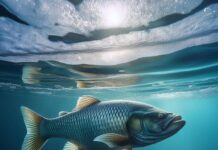PRATT – If someone wishes you a “crappie day” this time of year and you’re an angler, you accept that wish with a smile. It’s a good thing. Crappie anglers wait all year for late April and early May when water temperatures in Kansas lakes warm to the high 50s and low 60s. That brings one of our most popular sport fish to shallow water to spawn, making them available to anglers of all ages and skill levels. And crappie are popular because they may be the tastiest fish in our waters.
Spring is the only time of year when anglers fishing from shore or wading might have an advantage over boat anglers. When the spawn gets going, crappie can be caught in water as shallow as 2 feet, depending on the clarity. And since the fish will be concentrated in shallow areas with specific habitat, anglers often catch good numbers of fish on a single outing.
What’s good crappie habitat? Crappie like cover such as brush, cattails, flooded weeds or rocky areas. Rip-rap dams and jetties are perfect places to start fishing.
Crappie anglers prefer light tackle – spinning or spincast outfits rigged with 6- or 8-pound test line. A long, light-action rod is perfect for detecting soft strikes and working hooked crappie out of cover. Often called “paper mouths,” crappie have thin skin along their top jaw and can’t be “horsed” out of the cover without the hook pulling out.
Small white or chartreuse jigs or minnows are effective baits. The trick is getting your lure or bait in or close to the cover without spooking the fish or snagging up. One tried and true method is referred to as “doodlesocking,” which is simply dipping your bait vertically into the cover. The jig or minnow is worked slowly or held suspended 6 inches or a foot off the bottom before it is lifted straight up and repositioned. An 8-foot fly rod rigged with a spinning reel allows added reach and can be perfect for doodlesocking. Strikes are usually a “tap,” felt as the jig is held suspended. The angler must set the hook quickly and lift the fish straight up out of the cover.
Another popular method is to rig a small float 2 feet above the jig or minnow. The float can be cast along the brush or rocks and allowed to bob and drift with the breeze. Strikes can be subtle, often just moving the float or pulling it just below the surface.
The crappie spawn usually starts in the upper ends of reservoirs, with fish congregating in small coves and inlet creeks. The spawn will continue down the lake as water warms in the lower reaches. This can extend the spawn through the end of May.
According to the2015 Fishing Forecast, the top three reservoirs for crappie fishing this spring are John Redmond, Perry and Hillsdale. But don’t avoid your favorite fishing spot if it’s not high on the forecast’s list. Remember that the spawn season concentrates crappie in specific areas, so good fishing can still be found in lakes with only fair crappie populations.
You’ll find great fishing information on the Kansas Department of Wildlife, Parks and Tourism’s (KDWPT) website, www.ksoutdoors.com, including a full-length how-to video “Kansas Crappie Bonanza.” You can also keep track of lake temperatures and conditions, as well as angler success through the Weekly Fishing Reports.
The statewide creel limit for crappie is 50 fish per day. However, local creel and length regulations may vary, so be sure to consult of the2015 Kansas Fishing Regulations Summarywhere you’ll find a complete listing of Kansas lakes with special regulations. The regulation pamphlet is available at all KDWPT offices, license vendors and online.




